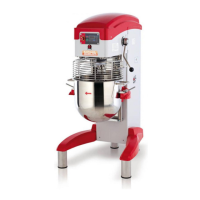
Do you have a question about the Sigma BM40 and is the answer not in the manual?
The mixer is equipped with safety devices like master switch, circuit breaker, and guards that must not be removed.
Lists applied safety standards like EN 292, EN 294, CEI 17-13, and EU Directives.
Risk of physical injury from moving parts if casing is removed or grid is bypassed.
Risk of electrocution if the mixer lacks an adequate earthing system.
Risk of injury from moving limbs into the mixer during its automatic operating cycle.
Key operational points including PPE, cleaning, safety devices, and stopping procedures.
Defines qualifications for operators, electrical and mechanical technicians, and personnel in charge of handling.
Provides contact details for requesting manual updates, customer assistance, spare parts, and training.
Highlights the need to pay attention to indicated operations, as non-compliance can cause harm or damage.
Explains the correct mounting of the bowl and closing of the protective grid for operation.
Details the procedure for inserting and locking the tool into the tool holder shaft.
Describes lifting the bowl and closing the grid to start the work cycle after ingredient insertion.
Identifies and describes the functions of buttons like STOP, START, MODE, EMERGENCY STOP, and display indicators.
Explains how to operate the mixer manually using the START button and the visual feedback on the display.
Describes the mixer's operation under digital timer control, indicated by moving blue lights.
Details how to set the minutes and seconds for the timer using the MODE, +, and - buttons.
Warns against changing speeds while the mixer is not running to prevent damage to belt and gears.
Notes that opening the grid or lowering the bowl while running will stop the mixer.
Suggests using the lowest speed setting initially, especially with the dough hook, to prevent damage.
Specifies requirements for installation: lit, ventilated building, solid/level support, temperature, and humidity.
States that lighting must be sufficient to read controls and signs without blinding the operator.
Mentions normal vibration levels and noise emissions of 70 dbA.
Addresses the machine's suitability for industrial environments and its incompatibility with explosive atmospheres.
Describes the information found on the mixer's identification plate and operator position.
Lists four types of packaging and provides dimensions for pallet+box and cage packaging.
Details technical data like model, dimensions, weight, bowl capacity, and power.
Provides instructions for safely handling the mixer using straps and appropriate lifting equipment.
Gives guidelines for handling the mixer when it is on a pallet, using lift trucks and ensuring safety.
Specifies conditions for storing packed mixers: closed, covered, smooth surface, temperature, and humidity limits.
Outlines storage requirements for unpacked mixers, including lifting from the ground and protection from elements.
Details the need for a stable, vertical position on a sturdy surface and anchoring if tipping is a risk.
Emphasizes that electrical connection must be done by a specialized electrician following standards.
Instructions for preserving the mixer during long periods of inactivity, including cleaning and disconnection.
States the warranty duration and conditions for it to remain valid, including proper use and maintenance.
Lists examples of improper use that would void the warranty, such as overloading or using unsuitable cleaning tools.
Explains the procedure for reporting defects and the supplier's responsibility for repairs.
Outlines periodic checks of safety systems and the electrical system by a specialized electrician.
Defines keys for control intervals (daily, weekly, monthly, annually) and methods (observation, function, measurement).
Describes the function of the Master switch and the Stop circuit/safety micro switch of the grid.
Mentions periodic checks of automation functioning, earthing, terminal boards, cables, LEDs, and earthing system.
Crucial warning not to perform maintenance or cleaning with electricity connected.
Recommends checking belt wear after the first three months of work.
Advises greasing and oiling specific points every 4-6 months using MOLYKOTE 165 LT grease.
Illustrates points for grease nipples and manual greasing on the mixer's internal mechanisms.
Specifies the type of power cable (H07RN/F 3x1.5 mm2) for replacement if damaged.
Advises on cleaning the mixer with a moist cloth, neutral detergents, and degreasing agents, noting it's not jet-proof.
Refers to authorized personnel for interventions like motor replacement, circuit board repair, or factory overhaul.
Outlines daily tasks including cleaning outside surfaces and checking operative/emergency controls.
Lists monthly tasks: thorough cleaning, controls check, external components check, and transmission noise check.
Details annual tasks: thorough cleaning/check, transmission organs check, and bolt tightening check.
Provides torque specifications for various screw types (Mixer screws, Stop rod screws, Mixer screws A2).
Specifies necessary information (mixer type, serial number, year) for ordering spare parts.
Details materials used (steel, cast iron, brass, plastic) and their disposal requirements.
States that the electrical system must be dismantled and disposed of by a specialized company.
Covers surface treatment (food-compatible paint) and compliance of packaging with directives.
Assigns responsibility to the purchaser for putting the mixer out of service according to local standards.
Emphasizes that dismantling mechanical and electrical parts must be entrusted to competent personnel.
Provides a diagram with numbered components for identifying spare parts.
Lists parts with position, quantity, code, and description for ordering.
Addresses issues where the master switch is on but the warning light does not turn on.
Covers reasons why the mixer fails to start after pressing the START button.
Explains potential causes and remedies for intermittent noise, such as lack of grease.
Addresses causes and remedies for continuous noise, including checking bearing efficiency.
Presents electrical diagrams for both three-phase and single-phase connections.
Informs users about the proper disposal of the appliance and its packaging at the end of its life.
Explains the organized differentiated waste collection managed by the manufacturer for recycling.
Warns that illicit disposal of the product may result in administrative sanctions.